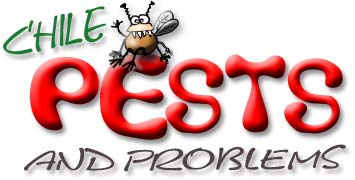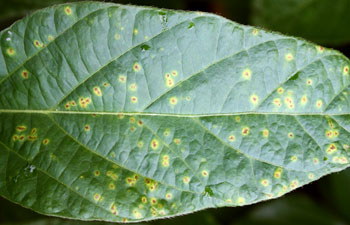By Dave DeWitt and Paul W. Bosland
Fiery Foods & BBQ Central Recommendations
Chile Pepper Bedding Plants… over 500 varieties from Cross Country Nurseries, shipping April to early June. Fresh pods ship September and early October. Go here
Chile Pepper Seeds… from all over the world from the Chile Pepper Institute. Go here
In 1987, game and fish department authorities in New Mexico gave farmers permission to shoot deer out of season. The reason? The deer were raiding chile pepper fields–a heinous crime in our state. They ate two acres of pods and severely damaged three additional acres. Although such deer depredations are unusual, they illustrate the fact that peppers damaged by more things than insects and disease.
In fact, reports of damage by other kinds of mammals and birds are common. Cats often graze on pepper seedlings, chewing them down to the soil. Parakeets and other pet birds have been known to do this too.
Dogs and pepper plants are not compatible. If allowed into the garden, dogs will dig up the plants or trample them. In one extreme case, a young Doberman ate the pods off a Cayenne plant! They have also been known to damage pepper plants by urinating on them. The urine turns the leaves yellow, causes them to curl into weird shapes, and stunts the plants. This problem on lawns is called “canine spotting syndrome.”
Food writer David Plotnikoff in San Jose, California, had lots of trouble with squirrels, which kept digging up his transplants. He finally built a frame over his peppers and stretched deer netting over it to keep out the squirrels. In south Texas, jackrabbits are a problem and must be fenced out of pepper fields. Famed chile pepper breeder Roy Nakayama once reported that skunks were eating the pods in some of his fields.
Commercial growers occasionally report that birds, especially some varieties of blackbirds, damage the pods on their plants by pecking through them to eat the seeds. Even a small hole in a pod can lead to a bacterial infection. Birds are particularly attracted to the small, red pods of Piquins, Ornamentals, and Exotics, and eat the pods whole.
Since most laws prohibit killing the animals and birds that raid peppers, there are two general solutions to the problem: isolate the plants with fences or netting, or scare the pests away.
Even under the best growing conditions, pepper plants may become diseased or infested. The correct diagnosis of a disorder is important in order to choose the proper treatment; selecting the wrong treatment is expensive and senseless. Diagnosing by reading a description of the problem, especially diseases, is difficult. However, with practice and the information in this chapter, the gardener can make an educated guess.
Diagnosing plant health problems is a three-step process. Frequent examination of the pepper plants leads to the first step in the diagnosis: perceiving the problem. The next step is determining the cause, and the final step is an appropriate solution based on information gathered in the first two steps.
A thorough examination of the plants is necessary, so use a hand lens to look closely at unhealthy tissue. Are fungal spores, such as those of powdery mildew or anthracnose, present? Are leaf spots oozing a slimy material, possibly an indication of a bacterial infection? Are any insects present?
Root problems usually have non-specific symptoms, such as wilting, yellowing, or dieback. The gardener will not always be able to determine the cause of the problem while investigating, and samples may need to be sent to a university or diagnostic laboratory for further testing. The laboratories best accomplish soil testing, microscopic tissue examininations, and plant disease organism culturing. The more information the gardener provides, the easier it is for a to find a solution. Follow the lab’s instructions on how to prepare and ship the sample, and provide a copy of all the information collected to the person responsible for the sample.
Each state provides assistance for home gardeners. The Cooperative Extension Service can help with a disorder because it has access to research information and resources of universities, the USDA, and other federal agencies. Some county agent offices have a series of telephone tape recordings on various gardening topics. The caller should request the recording be played before asking the agent specific questions.
Information gathered in the first two steps above is vital to decide what control or management procedures are necessary. Remember the principles of integrated pest and disease management when making a plan. The final plan may be similar for either an infectious or a noninfectious problem. Integrated-pest or infectious-disease management is accomplished by cultural methods as often as by pesticidal ones.
Be diligent and keep detailed records of observations. Do not depend on memory for important details, such as: when a symptom first appeared, when a problem was treated, weather conditions when the problem was observed, and which cultivars appeared more resistant or susceptible. A symptom may result from multiple causes, rather than from one isolated pathogen or environmental factor. Therefore, apply integrated diagnostics to diagnose and control the problem.
Non-living (abiotic) and living (biotic) agents can cause pepper disease and injury. Nonliving factors that cause disease include extreme levels of temperature, moisture, light, nutrients, pH, air pollutants, and pesticides. Living pathogens that cause disease include fungi, bacteria, virus, mycoplasmas, insects, and nematodes.
Two basic approaches to control pepper disease and pests are organic gardening techniques and synthetic (artificially produced) chemicals. Both methods have merits and can be used independently. However, combining these methods is often the most effective method to prevent disease and pests. Organic insecticides include rotenone, pyrethrum, and microbial preparations like Bacillus. The treatments listed in the chapter are generally needed to control the disease and/or pests. All treatments are not needed in all locations every year.
Pepper diseases can cause extensive losses in yield and quality. Disease and insect control in the home garden must start before plants and seeds are planted. Plan a long-range program and record, from one year to the next, the location of plant types. This menthod will help in effective crop rotation, which is one method of minimizing root rot disease caused by soil-borne pathogens.
Another important way to control disease is by using good cultural and sanitation practices. This includes proper soil preparation, fertilizing, watering, and early detection and removal of infected plants. The latter is especially helpful to avoid using fungicides.
An equally important, but often overlooked, disease control method is simply planting disease-resistant pepper varieties. Many pepper varieties are resistant to a virus, but some pathogens cause several viruses. Thus, multiple resistance must be incorporated for total protection. Two common pepper diseases, bacterial leaf spot and tobacco mosaic virus, are best controlled through resistant varieties.
Foliar disease is usually spread by splashing water. Therefore, foliage should be watered early in the day to allow it to dry before the evening hours. Proper plant spacing to provide adequate air movement around plants helps reduce disease severity. During frequent rainfall, foliar diseases becomes difficult to control, even with fungicides. However, fungicide should usually be applied at the first detection of disease. The general control measures can be summarized into seven key ideas:
- Provide adequate space between plants. This allows good air movement and will help control diseases.
- Plant healthy seeds and transplants. Disease can be introduced via infested seed or plants. Careful inspection is recommended. Purchase seed and transplants from a local, reputable, reliable source, such as a trusted garden center.
- Plant disease-resistant and -tolerant varieties when available.
- Use crop rotation: avoid planting the same or related crops in the same plot in successive years. Do not rotate tomatoes, eggplant, or potatoes to the same sites where peppers were planted the year before. Most pathogens die when suitable hosts are absent.
- Water plants in the early morning hours so that the foliage will dry. Watering the plants in the evening will create an ideal conditions for disease development and spread.
- Control insects early in the season because many of them transmit virus and bacterial disease to healthy plants. Aphids and leafhoppers transmit viruses and mycoplasmas from infected plants to healthy plants. Aphids feed on infected weeds, then move to the peppers, which introduces viruses that are spread in secondary cycles within the planting. In some instances, it only takes 5 to 10 seconds of feeding by an aphid to infect a pepper plant.
- Use sanitation techniques. Dispose of diseased plants and frequently clean and disinfect equipment and benches. Control weeds around the garden area because many disease organisms survive on weeds and can be transferred to peppers by insects and wind. Beware that perennial weeds can harbor reservoirs of destructive viruses over the winter.
For soilborne pathogens (Verticillium, Fusarium, Pythium, Rhizoctonia, nematodes, etc.), a chemical, such as metham sodium (Vapam), may be added to the soil. Vapam is especially useful in the greenhouse because it can be applied under plastic strips. In areas in which temperature and moisture favor disease, fungicides may require spraying every 5 to 7 days. However, in many areas, this frequency is not necessary. Fungicides should not be the only control method. Some or all of the above-mentioned measures must be used.
Important: All pesticides are under stringent restrictions of licensing, registration, and use at both federal and state levels in the United States, in Europe, and many other countries. Before a pesticide is applied to peppers, its package label should be reviewed to determine if it is allowed. Do not use any chemical if it is not labeled for peppers. If there are any doubts, consult the county agent or a responsible nursery person before using the chemical.
Excerpted from The Pepper Garden, published by Ten Speed Press in 1993.








